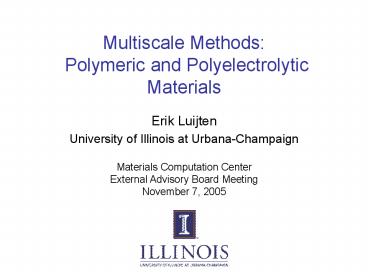Multiscale Methods: Polymeric and Polyelectrolytic Materials PowerPoint PPT Presentation
1 / 8
Title: Multiscale Methods: Polymeric and Polyelectrolytic Materials
1
Multiscale Methods Polymeric and
Polyelectrolytic Materials
- Erik Luijten
- University of Illinois at Urbana-Champaign
Materials Computation Center External Advisory
Board Meeting November 7, 2005
2
Overview
- Goal Advance understanding of polymeric
materials and biomaterials by synergy between
experiment simulationdevelop new methods
where necessary - Techniques
- Classical MD of coarse-grained models
- Classical MC, where helpful to overcome slow
dynamics(cluster methods for size-asymmetric
mixtures GCMC for coexistence) - Main projects pursued within framework of MCC
- Single-molecule translocation through membranes
- Dynamics of polymers near surfaces
- Self assembly and gelation of block copolymers
- Cross-interactions with other projects
- Electrostatically-driven self assembly
- Polyelectrolyteprotein complexation
- Counterion-mediated attraction between
polyelectrolytes - Colloidal self assembly
3
Illustration Gelation
- Self-assembly methods are widely advertised and
used to create new materials - Employ simulations to better understand dynamics
in self-assembly process as well as resulting
structures - Example triblock copolymers
Petka et al., Science.
4
Structure
Cluster formation coincides with
percolation transition
5
Dynamics
- Gelation shows a strong increase in viscosity,
but not the corresponding decrease in the
diffusion coefficient? Breakdown of SE - This is common in systems with dynamic
heterogeneities,confirming the strong
resemblance between gelation and glass formers - Importance Studies of self-assembly processes
frequently rely on single-particle tracking
methods!
Viscosity follows from stress autocorrelation
function
6
Polymer translocation
Polymer translocation through a nanopore studied
viaLangevin dynamics. We employ same techniques
for surface diffusion of adsorbed polymers
- Instantaneous velocity
- Various theories
- No simulations
- Not accessible in expt.
- Probe entropic barrier as
- a function of chain length
Chain departs fromequilibrium shape,in
contradiction withassumptions in mosttheories
fornonequilibriumtranslocation
- Explore effects of
- Polymerpore interactions
- Chain stiffness
- Ion flow within pore
- Heterogeneity(e.g., block copolymers)
- Hydrodynamics
7
Polarization charge calculation
Combine with molecular dynamics calculation
within LAMMPS In principle applicable to any
sharp interface between dielectric regions
8
Summary Impact Relevance
- Gelation
- Understand creation of hydrogels through
self-assembly - Understand effect of dynamic heterogeneities in
self-assembly processes on tracer diffusion ?
directly affects experiments! - Polymer translocation
- Understand driven diffusion through
membranes(biological processes, DNA sequencing) - In progress Self-consistent calculation of
polarization charge at interfaces for systems
with a discontinuous dielectric
constant(currently being incorporated into
LAMMPS by L. Guo)? impact far beyond
translocation of polyelectrolytes - Cross-interactions with electrostatic
self-assembly - Biological problems (DNA condensation),
biomaterials (hierarchical structures bound by
multivalent ions)

